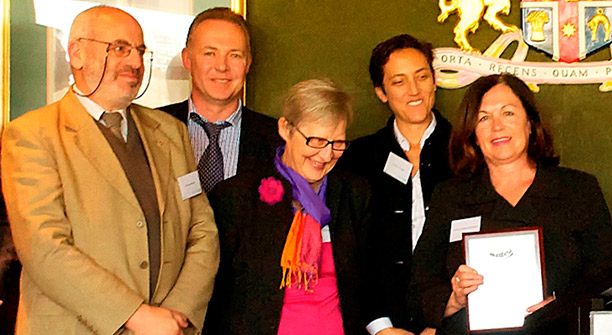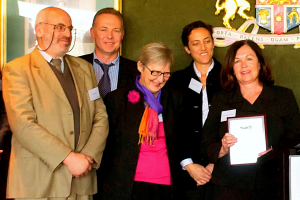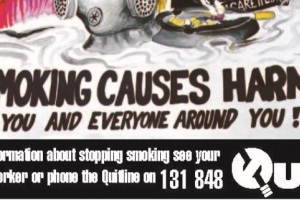Current Research
Prison research team: Professor Robyn Richmond (CIA), with Professor Tony Butler (UNSW)
Smoking bans were implemented in NSW prisons in August 2015, but their effectiveness in promoting long term cessation has not been established. An observational study is currently underway to examine prisoners' maintenance of abstinence from smoking following release from a non-smoking facility.
Previous Research
Prison research team: Professor Robyn Richmond (CIA), with Professor Kay Wilhelm (St Vincent’s Hospital), Dr Alex Wodak (St Vincent’s Hospital) and Professor Tony Butler (UNSW).
Prior to the prison smoking bans, prisons contained high rates of smokers (80%). Significant numbers of inmates come from the three main bastions of smokers in Australia: Indigenous people, those with a mental illness and substance users. These disadvantaged groups are less likely to access preventive health services such as smoking cessation programs in the community. Therefore, providing evidence based smoking interventions whilst in prison is an equitable offering for prisoners who do not access such interventions elsewhere. Robyn Richmond has led a National Health and Medical Research Council (NHMRC) funded randomised controlled trial (RCT) in New South Wales and Queensland prisons evaluating the effectiveness of a multi-component smoking cessation intervention. It was one of the first randomised controlled trials among smoking prisoners in the world. All 30 prisons in NSW and one in Queensland participated in the study. Recruitment of 425 male prisoners was followed by assessments at 3, 6 and 12 months. This study conducted in prisons validated the use of combination motivational approaches and nicotine replacement therapy for smoking cessation with one study group receiving active Nortriptyline and the other placebo. Outcomes from this research included provision of an evidence-based and useful model of intervention for incarcerated smokers across Australia.
During this study, a range of unique resources was developed in collaboration with prisoners: a poster advertisement, a calendar, Breakfree Booklet with step by step instructions for quitting, and a stressor package developed to assist prisoners during times they go to court or are transferred to another prison. Robyn Richmond worked with the Corrections System to develop and implement prison policy for tobacco control and smokefree prison wings. In terms of equity, it is imperative disadvantaged people are offered evidence based smoking cessation advice so that they too have the opportunity to lower their high smoking rates and concomitant high risks of mortality and morbidity from smoking and thus improve health outcomes.
The research team’s study was welcomed by prisoners and regarded favourably by prisoner staff, many of whom quit smoking as a consequence of participating in this study. In 2011, the research team won the Mental Health Matters Award for Research and Evaluation which “recognises individuals or organisations that have completed groundbreaking mental health related research studies, programs or initiatives, and whose findings have significant implications for the mental health field”.
Results from the study were presented at a symposium organised by Professor Richmond and Professor Amanda Baker at the European conference of the Society for Research on Nicotine and Tobacco in Turkey in 2011. The Symposium was titled: Killing them with kindness: Underserved populations and focussed on redressing the lack of proactive smoking policy and smoking cessation interventions for people with mental health and other problems in outpatient and inpatient settings and in prisons. Please see the SPHCM Globe newsletter.
The core elements for implementing smoking treatment involve offering cessation support and nicotine replacement therapy, training staff, identifying dedicated leaders or anti-smoking champions within prison and implementing organisational smoke free policies.
The team’s three prison studies, and an additional qualitative survey of participating staff, reported several important deliverable components that have been applied in the prison system.
- That smoking cessation treatment is best conducted in the prison clinic concurrent with other treatments where there is comorbidity among prisoners (e.g., smoking and mental illness). For those whose release is imminent, smoking cessation whilst imprisoned stands them in good stead on release into the community. Many prisoners said they wanted to improve their healthy lifestyle prior to rejoining their families on release, such as smoking cessation.
- Inmates participating in the study to quit smoking also began improving their diet and increasing physical activity. Implementing a healthy lifestyle intervention was an unexpected positive outcome of this study and is an important multi-component lifestyle approach in wider dissemination in prisons across Australia.
- Inmates and staff members including prison officers and clinic nurses expressed an interest in the smoking cessation program and positively participated in the studies. The research team found that among inmates and staff, there was a high level of interest in the continuation of their smoking cessation program. A nurse unit manager at a prison clinic attended the presentations on the study during recruitment of new prisons to participate in the study, and she talked favourably about her experience participating in the study. This experience guided the research team and when widely applying the smoking cessation intervention, it was important to include a clinic nurse in the training and delivery of the smoking cessation program.
- The research team activated the Mental Health Telephone service and established the Quitline telephone service for inmates.
- The smoking cessation study was attractive to prison authorities and prison staff, resulting in requests to participate from other NSW prisons. By extending the study into many more NSW prisons than originally envisaged, the generalisability of the study was increased. This came about partly because staff members involved in the project were transferred to other prisons not involved in the study, and they continued to use the study protocols in the new prison and encouraged smokers to quit. Transferral of knowledge about the intervention is crucial and this aspect was developed and reinforced.
- The research team was well aware of the high rate of smoking among prison staff officers and clinic staff. They realised that unless they addressed this issue, prison staff might undermine smoking cessation efforts among inmates, like offer tobacco, or not provide the anti-smoking medications. Prison staff were encouraged to quit smoking by attending a family doctor in the local community who could provide advice and nicotine replacement therapy for cessation. Alternatively, it was suggested they call the Quitline for advice.
- On the UNSW Prison Research Team’s advice, the NSW Correctional system restricted smoking to designated smoking cells and areas and developed a policy of not accommodating smokers with non-smokers.






